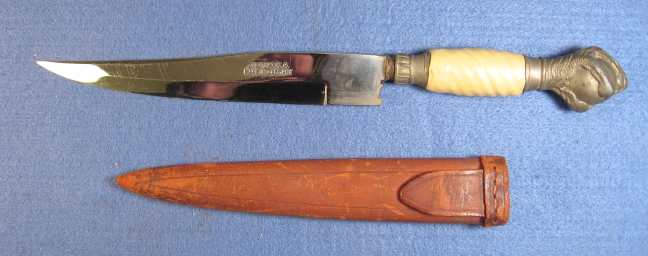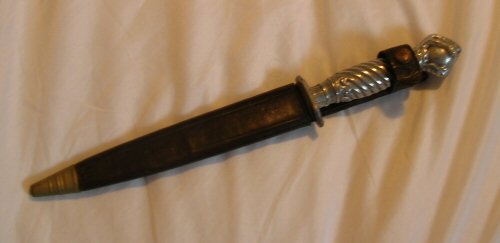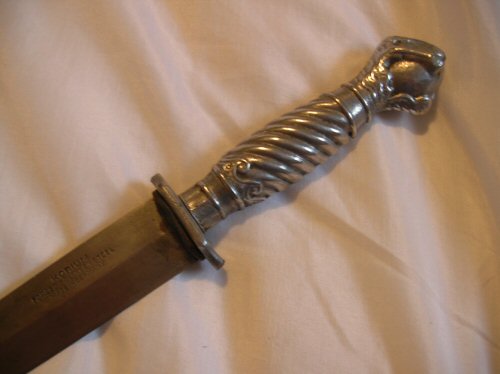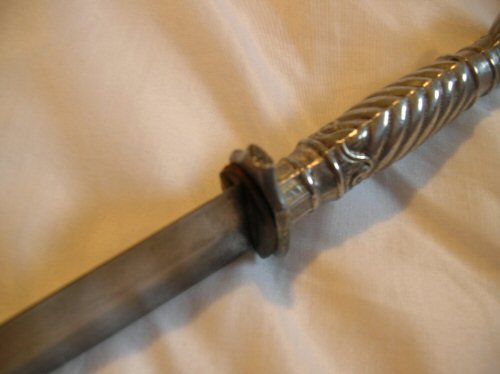Posts: 1,968 Location: Nipmuc USA
Sat 13 Apr, 2013 6:05 pm
It is quite possible that I had posted an ad in more than one thread. Give me a second her and I'll post that up.
The talon and ball daggers were made by a number of sources but the Korium probably the most common you will find. The quillons vary a bit between the separate Solingen sources and then there were the Japanese Korium knives. IF you plug Korium into Ebay, you will see the traffic of both German made and Japanese examples. Most notably is the scabbards between the two. A quite different build done by Jowika, before the company moving to Ireland from Solingen. Those Jowika knives earlier, so the motif predates the WWII period. All the alloy gripped hilts are 1950s to the 1970s. It was some time in the late 1960s when the Korium name went to Japanese manufacture.
These were my childhood dream and I had a plastic one when I was three. In the 1960 magazine and comic sales, it ws often of a penny being pierced. Some New Yoork out fit and I am forgetting the name of the distributor. I may have that in files as well.
Here is mine, I was recapturing my youth after a stroke a ew years ago.
[ Linked Image ]
[ Linked Image ]
These do rust and you can see in the above photo I must have not attended to it in a bit.
Here is one of the Ebay ads from some time ago and I had saved it because there was a relic having been sold as old.
[ Linked Image ]
And then the sad truth of a notable Civil War dealer selling the piece as old but going by the source of the story. The dealer could only add to me after the sale "That sure looks like our gal, buy all you can :) "
[ Linked Image ]
[ Linked Image ]
A good day for finding or a good day for drinking? :lol:
Let me see if I can find that Jowika in my files and maybe some other ad copy with the pierced penny. No luck on the penny ad on my current drives but it is out there on the net. The pre war Jowika blade shape a bit different. So anyway, the post war fad was a nod to an earlier pattern but as far as I know not so but often listed as a military pattern.
The blade washers are to help keep the blade to guard wear to a minimum with the alloy pieces. and with many o,ld swords, a part of assembly. By the 19th century, we often see the washer just acting as a bumper, or grease seal but even up to the 20th century a regular part used in seatling the blade to the guard (which is why so many 18th and 19th century military swords have a gap and loosness as the washer degrades).
Note also in your travels that the quillons are very fragile, hence so many missing them. These were extremely cheaply made and a novelty that appealed. The JApanese examples clearly marked and the scabbards for those riveted instead of the German back stitched knicker style scabbards with a metal tip
Cheers
GC
 Attachment: 19.73 KB
Attachment: 19.73 KB
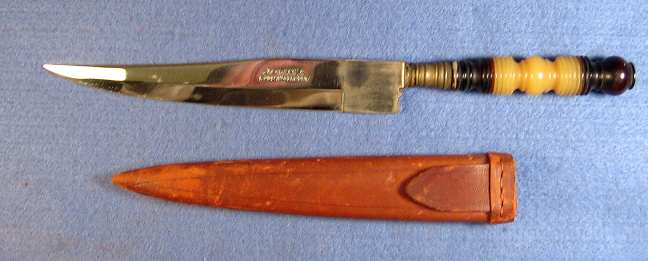
 Attachment: 16.85 KB
Attachment: 16.85 KB
